HGV Driving Hours in a Nutshell
Did you ever look over the regulations around HGV driving hours and got confused? They are quite complex! Nevertheless, keep in mind that these rules are there for your benefit, to protect you and others.
To make it simpler, we put together all the information you need to know about HGV driving hours in one easy to understand guide.
Depending on whether you’re driving around the UK or within the European Union, the regulations will be slightly different.
EU Rules on HGV Driving Hours Explained

Driving Hours
Keep in mind that all driving under EU rules must be recorded on a tachograph.
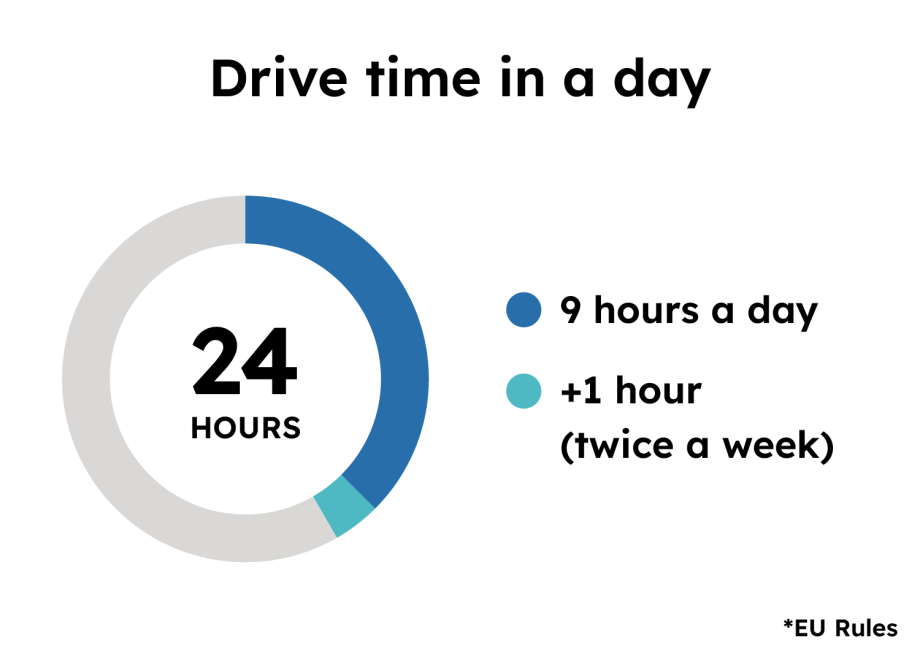
The main HGV driving rules relating to driving hours are:
- You can drive for up to 9 hours a day and this limit can be increased to 10 hours twice a week
- You can drive for a maximum of 56 hours a week
- You have to abide to a driving limit of 90 hours for any two consecutive weeks
The time you spend commuting from home to your worksite is not included in these hours.
Breaks
- Breaks are compulsory and necessary for the safety and health of the drivers.

You need a 45-minute break after 4.5 hours of driving.
In fact, it is mandatory to take a break of at least 45 minutes after a driving time of 4.5 hours. The driving period can be either continuous or divided into shorter periods adding up to a total of 4.5 hours.
You can also do split breaks. That’s means two breaks of minimum 15, respectively 30 minutes that must be completed after 4 hours and 30 minutes of driving. Your first break must be at least 15 minutes long, while the second break needs to be at least 30 minutes. Anyhow, you need to complete the total of 45 minutes of break after 4.5 hours driving.
Rest Periods
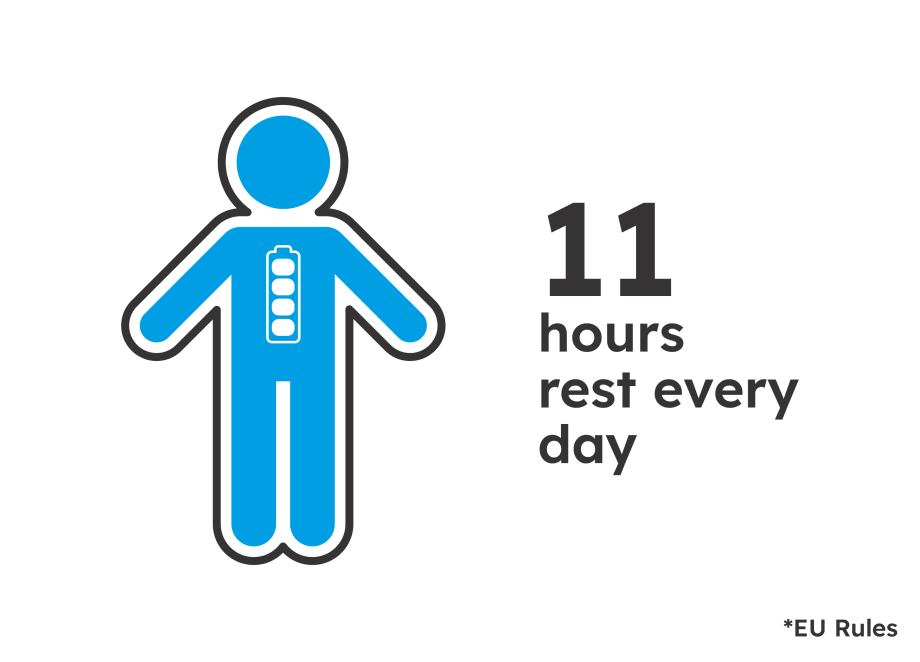
The regulated rest period is 11 hours every day. You can reduce this time to minimum 9 hours, but you can only do this three times a week.
You can split the daily rest period in two lumps. The first period consists of a minimum uninterrupted 3 hours, followed by a second uninterrupted period of at least 9 hours, with a total of minimum 12 hours.
You must observe a weekly rest period of 45 hours. This can be reduced to 24 hours, however you can do this every other week only.
AETR Rules
You may have heard of the European Agreement Concerning the Work of Crews of Vehicles Engaged in International Road Transport (or AETR) rules. These regulations cover all EU countries as well as basically all other European (or partly European) countries.
As far as HGV driving hours are concerned, the AETR rules are the same as the EU rules.
GB Domestic Regulations for HGV Driving Hours
Keep in mind that the GB domestic rules apply in Great Britain, as Northern Ireland has slightly different rules.
These HGV driving rules apply to drivers of passenger-carrying and goods vehicles that don’t have to follow the EU rules. Similar to the EU rules, you must record your driving hours using a tachograph or a record sheet.
Driving Hours
If you’re driving a goods vehicle for a company, your duty time is basically any working time.
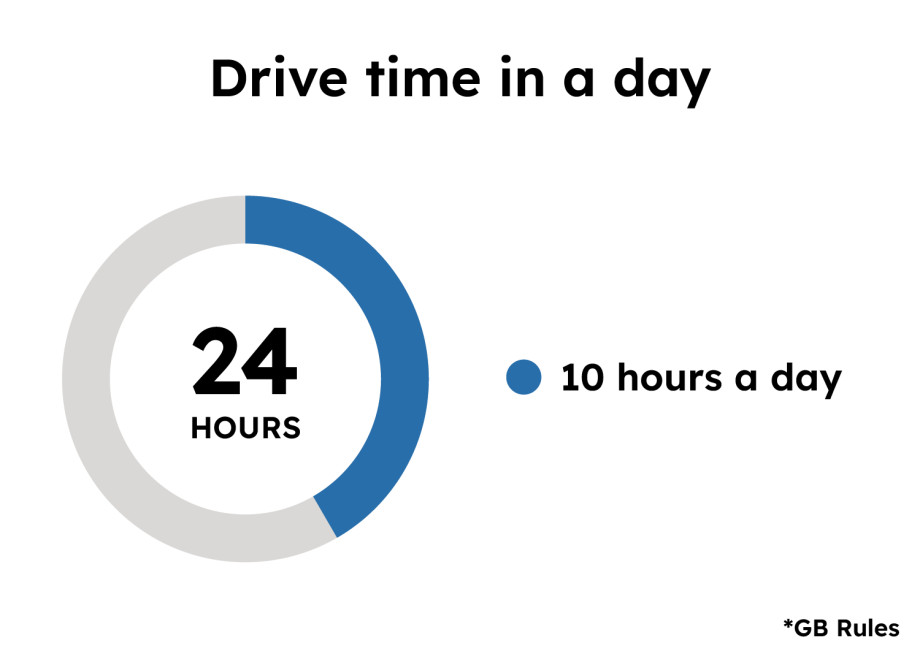
- You can drive for a maximum of 10 hours in a working day (compared to EU’s 9) if you’re driving on either a public road or off-road when you’re not during duty time. Off-road driving usually refers to agriculture, forestry, building road, quarrying, civil engineering.
- The driving time you can record over a period of 2 week is 90 hours.
- The time you can be on duty is limited to 11 hours a day.
You are exempt from following these driving hours if you are dealing with an emergency (like danger to life or any major disruption to public services), you are using the company’s vehicle for private driving, you are driving off-road during duty time, or you are driving a vehicle belonging to the police, fire brigade or the armed forces.
Similarly, if you work as a driver for a company and you’re driving a passenger-carrying vehicle your driving hours are limited to 10 hours in a working day.
Breaks
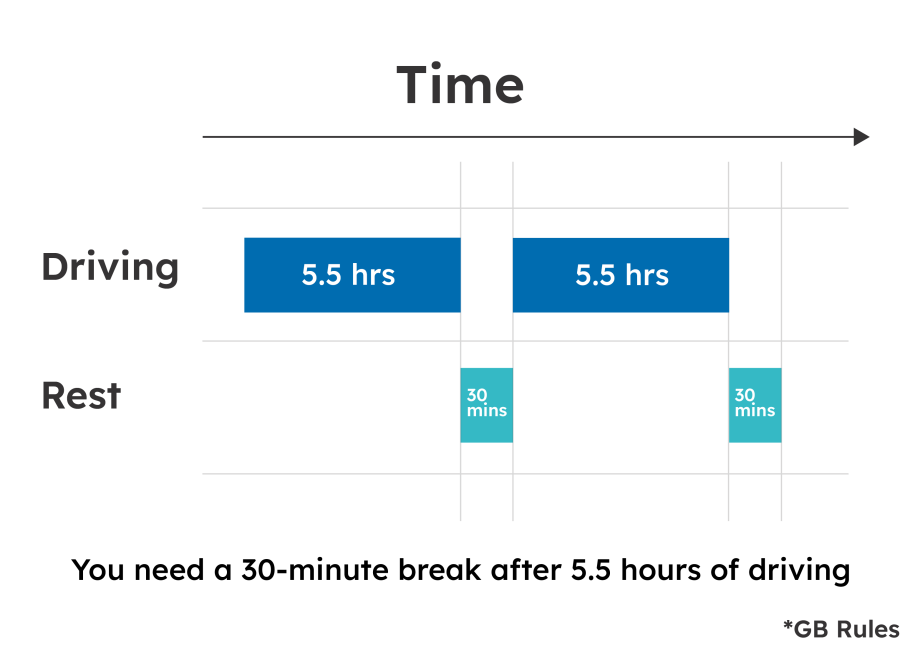
You must take a minimum 30 minute break if you’ve been driving for 5 hours and a half. There is also a mandatory 45 minute break within any period of 8 hours and a half. On top of that, you must take a 30 minute break at the end of said period, unless it’s the end of your working day.
Rest Periods
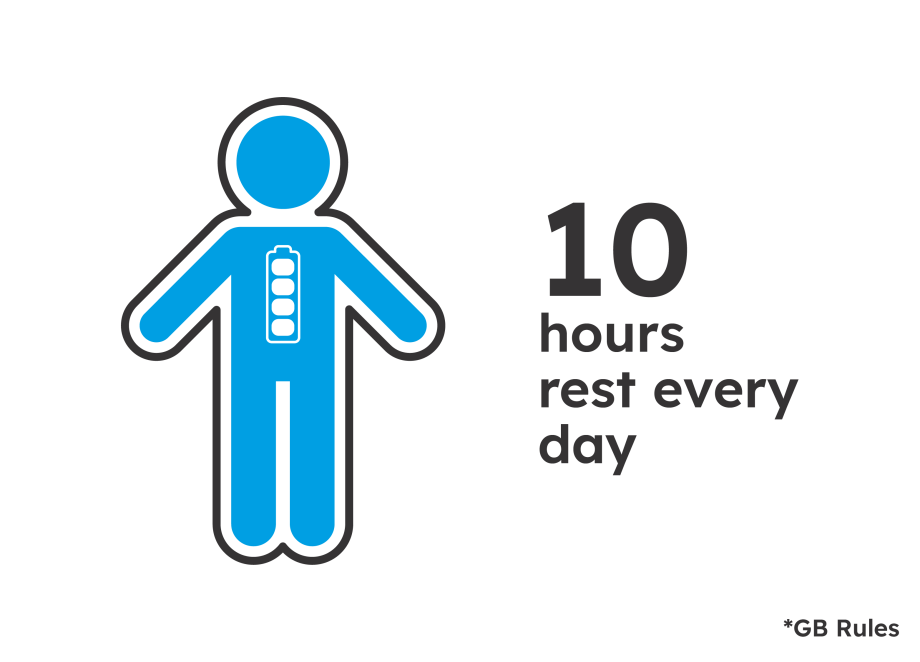
Did you rest for 10 hours before your first duty as well as after your last duty in a working week? Well, that’s what you’re required to do. You also have to rest for 10 hours between 2 working days, although this time can be reduced to 8.5 hours for 3 times a week.
Remember to rest for 24 hours every fortnight. We know you enjoy driving for work and you might not like that, but hey, it’s the law.
Northern Ireland Domestic Rules
If you’re driving in Northern Ireland, make sure you are well informed and driving under the correct rules.
- Maximum driving time per day is limited to 10 hours
- You can drive continuously for a period of up to 5 hours
- You must take a 30 minute break after driving for 5 hours
- In any period of 24 hours the driver must take 10 consecutive hours rest.
Of course, records must be kept and a tachograph must be used.
Driving Internationally?
Are you driving under both EU and GB domestic rules? Make sure you know the rules and follow them accordingly.
As far as driving hours go the EU rules apply, while the GB domestic rules apply for duty limits.
Follow the rest periods set by the EU standards when driving under these rules.
If you want to read through all the relevant full documents on HGV driving hours, you can find them on the UK gov website.
iCompario tip:
If you’re trying to find a cheat code, you’re probably wasting your time. The time spent driving under EU rules does not count as off-duty under GB domestic rules. Just as driving under GB domestic rules is classified as “attendance at work” and does not count as a break or rest time under EU rules.
Rules for Employers
Are you an employer? Here are the rules you need to know about.
Your company might employ drivers, as well as mobile workers. The term “driver” hardly needs any explaining, but you might be wondering what “mobile workers” are.
Mobile workers include drivers (employed drivers, own-account drivers, and agency drivers), members of the vehicle crew like the second driver on a coach, as well as any member part of the travelling staff, like a drayman, a bus conductor, or a security guard if you’re transporting valuable goods.
First of all, as a company who employs HGV drivers, you need to be aware of all the rules and regulations on HGV driving hours in UK and not only. You need to train your drivers with regard of HGV driving rules and make sure they properly understand them.
Keep records of your drivers’ hours and make sure to check the records and data related to your drivers’ hours and monitor their working time.
Track Your Drivers’ HGV Driving Hours
Around 10% of accidents in the UK happen because of tiredness. The HGV driving hours directives are implemented to protect you, keep roads safer, and prevent fatigue while driving.
The fleet management business can be challenging, and we get how tracking drivers’ activity can be a real hassle at times.
Fortunately, there are solutions that you can count on. Using a good telematics platform, you can work less and smarter.
A good telematics solution can include a dash cam designed specifically for commercial vehicles. It lets you watch video footage instantly in clear HD, from anywhere. You can also download video remotely, eliminating the need to bring the vehicle on site.
The tachograph data feature can help you better monitor your drivers and ensure that they’re following the HGV driving rules and hours. Other features you can opt for include live location tracking, temperature sensors and alerts, CAN data, real-time vehicle diagnostics, and more.



